For now, the world is intensely focused on the Gaza War, the humanitarian crisis, and the possibility of it widening into a regional conflict. And Russia’s invasion of Ukraine is seen as probably the greatest danger to global security because of the explosive combination of its impact on neighboring NATO countries and the threats by Vladimir Putin to use nuclear weapons. Even if they are used tactically, a nuclear attack is potentially the opening salvo to what could become a full-scale nuclear war.
What has not been given much attention is the effect elsewhere of competition between countries where an asymmetrical action taken by one country is seen as undermining a core element of the survival of another. Riparian rights to the waters of the Blue Nile are potentially just such an explosive issue.
The waters of the Nile have long been a point of contention between Ethiopia, Egypt, and Sudan, with a history of past and present superpowers shifting allegiances at any given moment in time.
The new development in this equation has been both impressive and contentious, namely the hydroelectric dam on the Nile — the Grand Ethiopian Renaissance Dam (GERD) — that is at the core of Ethiopia’s national ambitions. The dam lies across the Blue Nile, which originates in Ethiopia and accounts for around 85% of the water that eventually flows through the Nile downstream in Sudan and Egypt.
In 2011 Ethiopia launched the construction of the Grand Ethiopian Renaissance Dam without consulting either Egypt or Sudan (or the Republic of South Sudan which was founded in July 2011), maintaining it was within Ethiopian sovereignty. The Grand Ethiopian Renaissance Dam ultimately would cost over $5 billion.
There was clearly a need for some resolution of the parties going forward. In 2015 the three countries signed a Declaration of Principles (DoP) that recognized that Ethiopia might go forward with the Grand Ethiopian Renaissance Dam, but with a proviso: Ethiopia should implement recommendations included in the final report of the Tripartite National Technical Committee dealing with different stages for the dam operations.
Essential to this was the condition that an Environmental and Social Impact Assessment (ESIA) be carried out. This was to be done before the dam construction went forward and set rules for filling the dam and the manner of its operation. Ethiopia refused an ESIA, a pivotal decision that has shadowed discussions but, nevertheless, there have been talks and negotiations. In 2022, as I wrote here, there was some hope that some agreement might be reached.
Recently, Ethiopia and Egypt reported that their latest round of talks ended with no deal. Egypt’s Ministry of Water Resources and Irrigation blamed Ethiopia’s “persistent refusal” to accept any compromise. The Ethiopian Foreign Ministry accused Egypt of putting up “roadblocks” that prevented any consensus.
The Grand Ethiopian Renaissance Dam: A high-tension situation
This is where we are now. It continues to be a bubbling, high-tension situation in a crucial corner of Africa, but one that tends not to be much watched or worried about enough by many at this time.
From Egypt’s vantage point, the regional issues revolve around access to water, on which its population and economy rely. Egypt is, in essence, “a river island country surrounded by sand.” Until this aspect is resolved, there is no certainty about what actions it will take.
At the same time, there is another important the Grand Ethiopian Renaissance Dam-related aspect, namely the huge power generation that the dam produces, how it is used within Ethiopia, and possibly shared outside.
Who will benefit most from the new electricity provided by the Grand Ethiopian Renaissance Dam, the People?
The Ethiopian Government’s position is that the Grand Ethiopian Renaissance Dam will help 60% of its 120 million population gain access to electricity and sustain its manufacturing industries. By doubling the country’s annual electricity supply, it will provide affordable electricity to the service, industrial, and agricultural economic sectors.
In theory, it could also supply electricity to Sudan and Egypt.
Filsan Abdi of the Ethiopian Ministry of Women, Children, and Youth argues that “It will not only bring reliable power to that country but promises a culture shift welcomed by many […] Mothers who’ve given birth in the dark, girls who fetch wood for fire instead of going to school — we’ve waited so many years for this — centuries. When we say that Ethiopia will be a beacon of prosperity, it starts here.”
The compelling case for this new source of power, the most important “interest” in this case is the welfare of all the populations living along the Nile: The Ethiopians need electricity to pull themselves out of poverty and achieve a decent living, and Egyptian and Sudanese farmers and all the riparian people need water from the river to survive.
There are negative consequences of this large dam in Africa, with respect to the environment. It can create large amounts of greenhouse gas emissions, especially methane as a result of rotting vegetation at the bottom of the reservoir.
New industries hungry for power? The likely impact from AI and cryptocurrencies energy demands
With the surge of newly available power comes the lure of making money by selling it to outsiders with a voracious appetite for power. Here is where those with money compete with those who do not. The new demand arises from two sectors both related to digital advances: artificial intelligence (AI) and the bitcoins industry.
The exploding rise of AI has created new demands. A recently published peer-reviewed analysis lays out some early estimates. In a middle-ground scenario, by 2027, AI servers could use between 85 and 134 terawatt hours (Twh) annually. That’s similar to what Argentina, the Netherlands, and Sweden each use in a year and is about 0.5% of the world’s current electricity use.
And there is the rise of the bitcoins industry that faces a huge energy consumption problem. As explained by the Rocky Mountains Institute (RMI, founded in 1982 with the aim to improve America’s energy practices):
“Cryptocurrency has an energy consumption problem. Bitcoin alone is estimated to consume 127 terawatt-hours (TWh) a year — more than many countries, including Norway. In the United States, cryptocurrency activity is estimated to emit from 25 to 50 million tons of CO2 each year, on par with the annual emissions from diesel fuel used by US railroads.”
Ethiopia, with its close ties to the People’s Republic of China, has become an attractive option as a new power-rich country. Unsurprisingly, Chinese firms now looking for affordable energy and not having to worry too much about the political winds turning against them, having found the Grand Ethiopian Renaissance Dam.
Out of the 21 electricity-supply deals made for mining, 19 were made with Chinese companies. This for sure indicates that Chinese companies prefer this solution over Texas for geopolitical reasons.
The Bottom Line
The Ethiopian Government will seek to demonstrate it can benefit its underserved people, agriculture, and domestic industries, and supply new AI and bitcoin industry demands while increasing government coffers and services.
What it cannot readily do is determine what Egypt will do without having reached an agreement on water availability. For them, that is a central national security concern. If an agreement is intractable, it will be devastating for the countries involved, and far beyond.
Editor’s Note: The opinions expressed here by authors are their own, not those of Impakter.com — In the Cover Photo: The Grand Ethiopian Renaissance Dam, Ethiopia, July 2016. Cover Photo Credit: Water Alternatives Photos.









